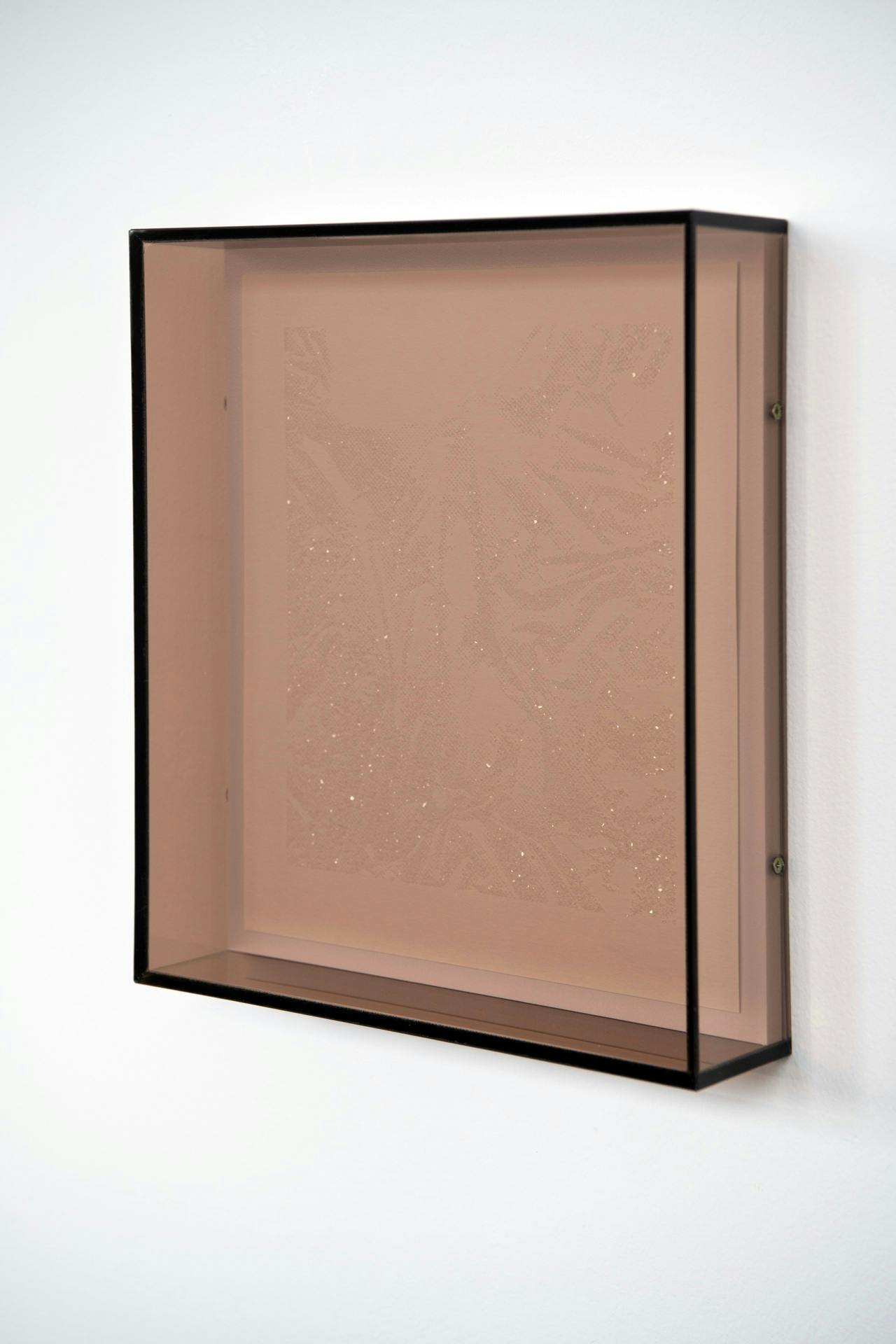Writing
Style and Substance: On the Work of Will Hughes
First published to coincide with the launch of Will Hughes' print edition 'Diamonds Are Forever, They Are All I Need to Please Me' (2025), a collaboration with hardcopy.

Diamonds Are Forever, They Are All I Need to Please Me (2025)
Silkscreen print hand finished with Diamond Dust
Southbank coarse 310gsm paper
Presented in custom tinted perspex box frame (5mm Neutral 9T13 Perspex)
24 x 28.5 x 6cm (framed)
Edition of 20 (+7 AP)
Reading time 5'
Hair down to my shoulders. Orange flared corduroy trousers—charity shop cream polyester shirt, topped with an indigo velvet jacket and a pair of trusted Doc Martins. I thought I was dapper; others were less sure.
On a car journey to see Will Hughes’ new artwork, Diamonds Are Forever, They Are All I Need to Please Me (2025), we discuss fashion, glamour, and style — themes that permeate the artist’s work and topics that remain close to my own heart. I’m reminded of my journey through various stylistic phases over the years and concede that I’ve become restrained as I’ve aged.
Style, of course, isn’t about other people: it’s an unbridled version of the self. It is armour and camouflage, seduction and transformation. It is part shield and lance, at once protective and interrogative. Art does something similar: it situates the self amid all the uncertainty. Like clothing, it brings feeling and thinking into conversation with materials and forms, communicating something that transcends the verbal and textual.
Hughes’ work is saturated with intimations of desire and glamour married to concise form. A tender kiss. A fleeting smile. A feeling of intimacy that remains slightly out of reach. Their work is a form of 21st-century impressionism, offering an archive of fleeting, intangible moments: full of evocation and suggestion.
Hughes commonly recontextualises humdrum items, including sponges, spoons, and headphones, surfacing concealed resonances. Car parts also often appear, including window wiper motors, steering wheels and rearview mirrors. These objects are irritated out of their usual context and cast into new formal and thematic conversations. Frequently, the artist pairs ersatz materials with desirable objects or vice versa: plastic that resembles crystal, flock and faux leather among others.
In Do you think this feeling could last forever? You mean like forever ever? (2021) an automated yellow sponge stutters in a circular motion courtesy of a mirror ball motor inside a transparent glass light shade. The staccato rhythm is full of tension, as if waiting to burst into life. This latency is a motif in the artist’s work. Movement appears frequently and is often looped and repetitive. We can draw parallels between the temporal quality of GIFs and TikTok videos: the promise of resolution is persistently thwarted, leaving us in a purgatorial state of seduction. As we await gratification, the animation loops us back to the start.
This irresolution — a pirouette between desire and refusal — persists in the material and formal qualities of Hughes’ work: cheap things are made to look expensive; forms teeter on the brink of explication and expectation.
In Diamonds Are Forever, They Are All I Need to Please Me (2025) an everyday plastic bag is rendered in diamond dust. The bag’s form has been altered to sharpen the contrast, and it is then screen-printed before a varnish is applied and sprinkled with dust. Hughes found the commercially bought dust (which is actually crushed glass) to be too coarse and ground it with a pestle and mortar. The image comes into focus at moments as the iridescent sheen catches the light at specific angles before fading back into an abstract monochrome. The print is framed in a semi-transparent Perspex box redolent of Sixties conceptual art. The semi-opaque framing partially obfuscates the image by dampening the light, adding to the elusiveness. The title — like all the artist’s — is lifted from a pop song, in this case, Shirley Bassey’s hit of the same name. As in other works, Hughes pairs melodrama with minimalism. These seemingly oppositional approaches — abundant emotionalism meets a more restrained aesthetic tenor — heighten an intractable tension.
Plastic bags have myriad metaphorical associations. They gather, protect, and conceal. They suggest convenience but have more recently become aligned to toxicity and environmental degradation. Plastic bags have largely disappeared from our daily lives, a leftover from a more neglectful era. They are nearly worthless, yet they remain on the ground for centuries. Many scientists believe that the thin crust of plastic will be the only archival presence of our current epoch. Diamonds, on the other hand, are value-rich. They are associated with bling, status and longevity and are among the strongest materials on the planet. Glass posing as diamonds echoes the Hackney slang ‘Hackney diamonds’ — the glittering remains of smashed car windows after a robbery. Iconography and a sly iconoclasm; everyday things made to look fancy: the work enacts a recurrent motif in Hughes’ practice as the grand and commonplace are elided.
What emerges is a form of material code-switching, playfully pulling apart dominant codes and aesthetics. Those with limited means often use creative expression to build alternative forms of social and cultural capital. There is a class element to much of this, a matter of self-definition: amplifying and archiving the self beyond enforced expectations.
As Hughes understands, status and value are not static; they drift and morph. Art is where images and materials are placed into fresh conversation, and ideas become mobile. It is a place where plastic can be transformed into crystal, and glass becomes diamonds. Expectations can be upended, and artworks can become generative sites for new insights and feelings. Where style changes but substance remains.